Identifying Brúnanburh: ón dyngesmere – the sea of noise
Scholars each have their own rationale as to the ‘site’ of this momentous battle. Their thirst for recognition has created diverse arguments, some flooding the media, others proposing to the point of acrimony that they have this ‘site’. The ‘conundrum’ is whether any identification of the ‘site’ is correct for all, apart from the circumspect, have taken assorted place-names similar to Brúnanburh as their starting point. The author chose to disregard the place-name approach and look at the topographic references in the manuscript. The first references were maritime then latterly landscape leading to field-names which have a more stable base than the constantly changing place-names. He found inconsistences in various positions held by some scholars to that of historical record about Brúnanburh. One major stumbling block was the phrase “ón dingesmere” which has created controversy, some scholars totally dismissing it but the ‘sea of noise’ appears to have some scientific foundation. Obviously it had some special significance to the Anglo-Saxon’s and their Christian allies and may well have been a kenning. Importantly, ‘who were these allies?’ The challenge for the author was to unearth the correct locale of these historic events. As an archaeologist he decided to interpret the topographic phrases in the manuscript evidence as material culture. The results were surprising.
{{comment.content}}








 京公网安备 11010802027623号
京公网安备 11010802027623号